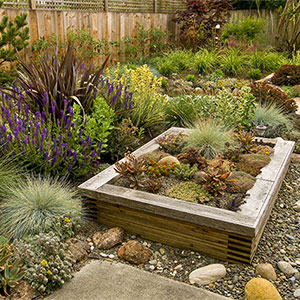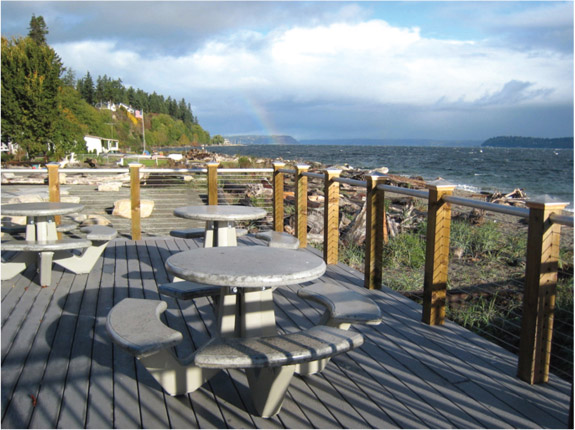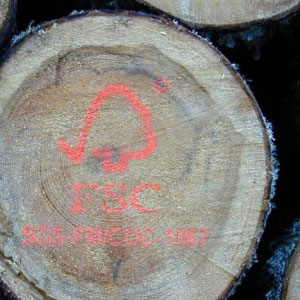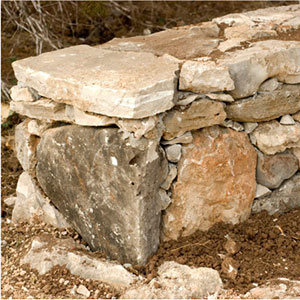
Attractive raised garden beds can be made from reclaimed wood. Image credit: Shutterstock/shippee
Reduce, Reuse, Recycle
You can minimize the negative impacts of materials and product manufacturing by strictly adopting this mantra: reduce, reuse and recycle.
Reduce: Use less.
To reduce simply means to do more with less. It’s a good idea to keep this minimalist approach in mind whenever using materials that impact human health and the environment.
Reuse: Make used or discarded things new again.
Reuse is one of the most effective strategies for offsetting the environmental and human health impacts of material or products. When you reuse reclaimed brick, for example, you do not need to mine the raw material or fire it in a kiln. If it is already on site, you don’t need to expel greenhouse gases in transporting it. Nor do you need to send the old brick to a landfill. Reclaimed materials can provide design details and a historic perspective that make the landscape unique, and they are likely to save money.
When shopping for reclaimed materials, homeowners now have a variety of options. Research local resources for reclaimed materials and develop a list of vendors in your area. Common suppliers include recycling centers, salvage stores, Habitat for Humanity and websites like freecycle.org or craigslist.
A few tips for getting started:
- Consider the many options. Reclaimed materials can be used in whole form or deconstructed and dismantled for reuse as a completely new object.
- Be creative. Homeowners should be open to new and creative ways in which materials may be incorporated into the landscape. When reusing materials it is often helpful to let the material inspire the design.
- Locate materials early in the design process. Determining what materials are available for reuse early in the design process will allow time for creativity and design exploration.
- Select materials that can be reused. When designing new site features, select durable and nontoxic materials in modular and or standard sizes.
- Design for deconstruction. Design site features to be disassembled without unreasonable effort or extensive damage to the material. For example, use screws instead of nails and avoid the use of glues or other liquid adhesives.

A children’s garden makes creative use of an unwanted juniper stump at the Lady Bird Johnson Wildflower Center in Austin, Texas. Image credit: Heather Venhaus

The vast majority of all steel is recycled back into new steel products with no loss of its physical properties. As such, steel isn’t just recycled but “multi-cycled,” as it can be used over and over again. Image credit: Wikimedia Commons
Recycle: Use recycled materials and recycle what you use.
Materials that are collected, reprocessed and used again to make a new product are known as recycled materials. Recycled materials lessen the need for virgin feedstock and avoid sending useful materials to the landfill; however, significant energy and other resources are often required during the recycling process. Because of this, recycled materials should be considered after options to reduce or reuse materials have been fully explored.
Landscapes can support the use of recycled materials in two ways: by incorporating materials made with recycled content — typically the higher the recycled content the better — and by purchasing materials that can be easily recycled in your area.
Post-consumer vs. pre-consumer content:
Materials can contain either post-consumer or pre-consumer recycled content. Of the two, post-consumer items are preferred because they are made from materials that were once consumer items and have now been diverted from a landfill. Pre-consumer content typically comes from the manufacturing process and can often be broken down and remade into similar or different materials.
What materials can be recycled locally? Where are the recycling centers?
Unfortunately, all materials cannot be recycled in all areas. Knowing the materials accepted by local recycling centers can help homeowners make more informed decisions. Research local recycling centers and compile a list of what centers accept what types of materials.
Use minimally processed materials.
The ecological and human health impacts of materials typically increase which each additional manufacturing phase. Therefore, materials that have reduced manufacturing and processing requirements often pose fewer environmental and human health risks.
Examples of minimally processed materials include:
- Uncut stone
- Earth materials
- Wood
- Bamboo

Decks and patio furniture can made from recycled plastic “lumber.” Image credit: Clinton Beach Park, Whidbey Island, Washington






